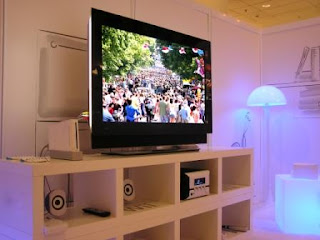 A plasma display panel (PDP) is a type of flat panel display common to large TV displays 30 inches (76 cm) or larger. They are called "plasma" displays because they use small cell containing electrically
A plasma display panel (PDP) is a type of flat panel display common to large TV displays 30 inches (76 cm) or larger. They are called "plasma" displays because they use small cell containing electrically
charged ionized gases, which are plasmas.
Plasma display advantages and disadvantages
Advantages
- Capable of producing deeper blacks allowing for superior contrast ratio[5][6][7]
- Wider viewing angles than those of LCD; images do not suffer from degradation at less than straight ahead angles like LCDs. LCDs using IPS technology have the widest angles, but they do not equal the range of plasma primarily due to "IPS glow", a generally whitish haze that appears due to the nature of the IPS pixel design.[5][6]
- Less visible motion blur, thanks in large part to very high refresh rates and a faster response time, contributing to superior performance when displaying content with significant amounts of rapid motion.[5][6][8][9]
- Superior uniformity. LCD panel backlights nearly always produce uneven brightness levels, although this is not always noticeable. High-end computer monitors have technologies to try to compensate for the uniformity problem.[10][11]
- Unaffected by clouding from the polishing process. Some LCD panel types, like IPS, require a polishing process that can introduce a haze usually referred to as "clouding".[12]
- Less expensive for the buyer per square inch than LCD, particularly when equivalent performance is considered.[13]

Disadvantages
- Earlier generation displays were more susceptible to screen burn-in and image retention. Recent models have a pixel orbiter that moves the entire picture slower than is noticeable to the human eye, which reduces the effect of burn-in but does not prevent it.[14]
- Due to the bistable nature of the colour and intensity generating method, some people will notice that plasma displays have a shimmering or flickering effect with a number of hues, intensities and dither patterns.
- Earlier generation displays (circa 2006 and prior) had phosphors that lost luminosity over time, resulting in gradual decline of absolute image brightness. Newer models have advertised lifespans exceeding 100 000 hours, far longer than older CRTs [4][7]
- Screen-door effects (black lines between rows of pixels) become noticeable on screen sizes larger than 127 cm (50 in); the effect is more visible at shorter viewing distances.[15]
- Uses more electrical power, on average, than an LCD TV using an LED backlight. Older CCFL backlights for LCD panels used quite a bit more power, and older plasma TVs used quite a bit more power than recent models.[16][17]
- Does not work as well at high altitudes above 2 km[18] due to pressure differential between the gases inside the screen and the air pressure at altitude. It may cause a buzzing noise. Manufacturers rate their screens to indicate the altitude parameters.[18]
- For those who wish to listen to AM radio, or are amateur radio operators (hams) or shortwave listeners (SWL), the radio frequency interference (RFI) from these devices can be irritating or disabling.[19]
- Plasma displays are generally heavier than LCD, and may require more careful handling such as being kept upright.


Post a Comment